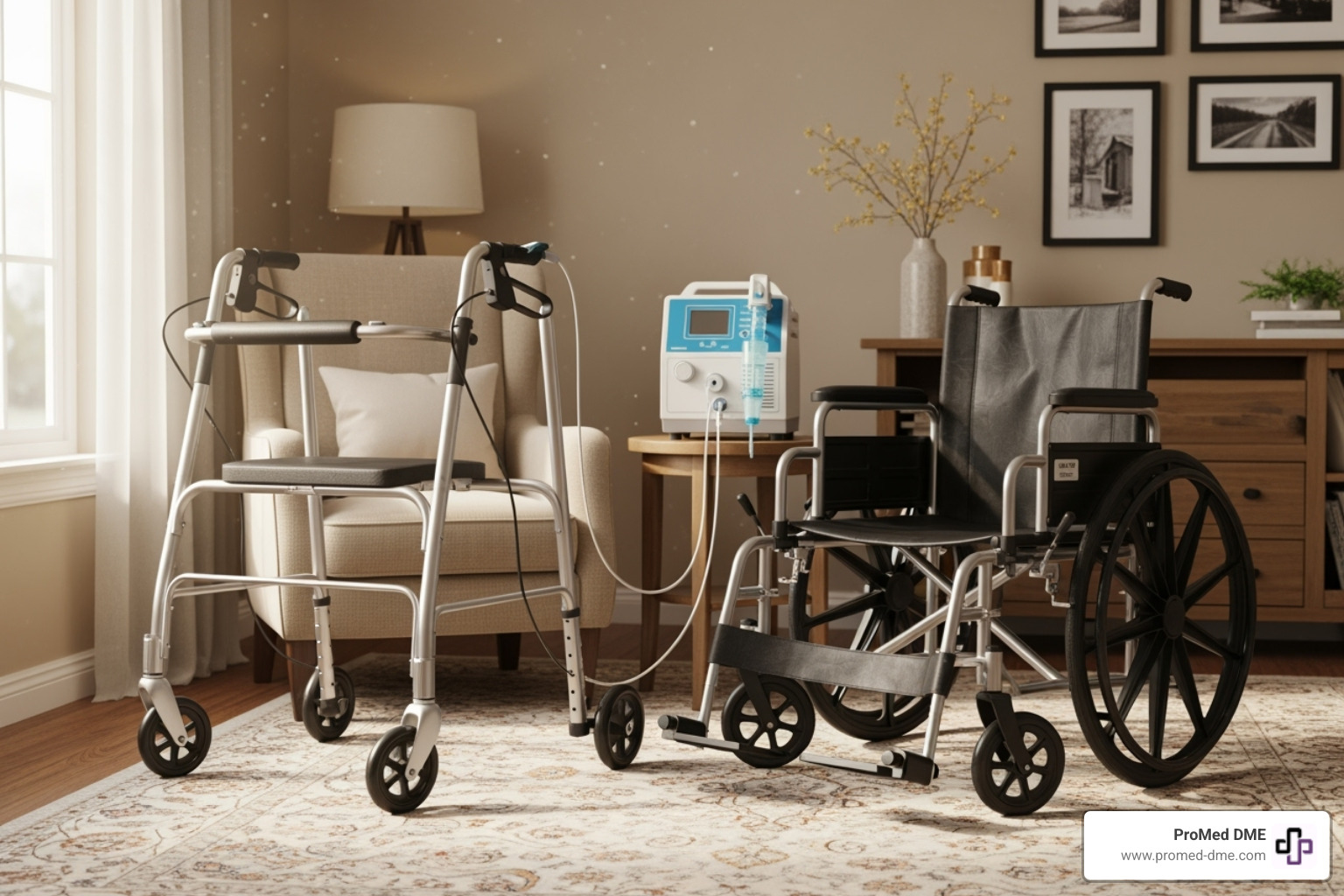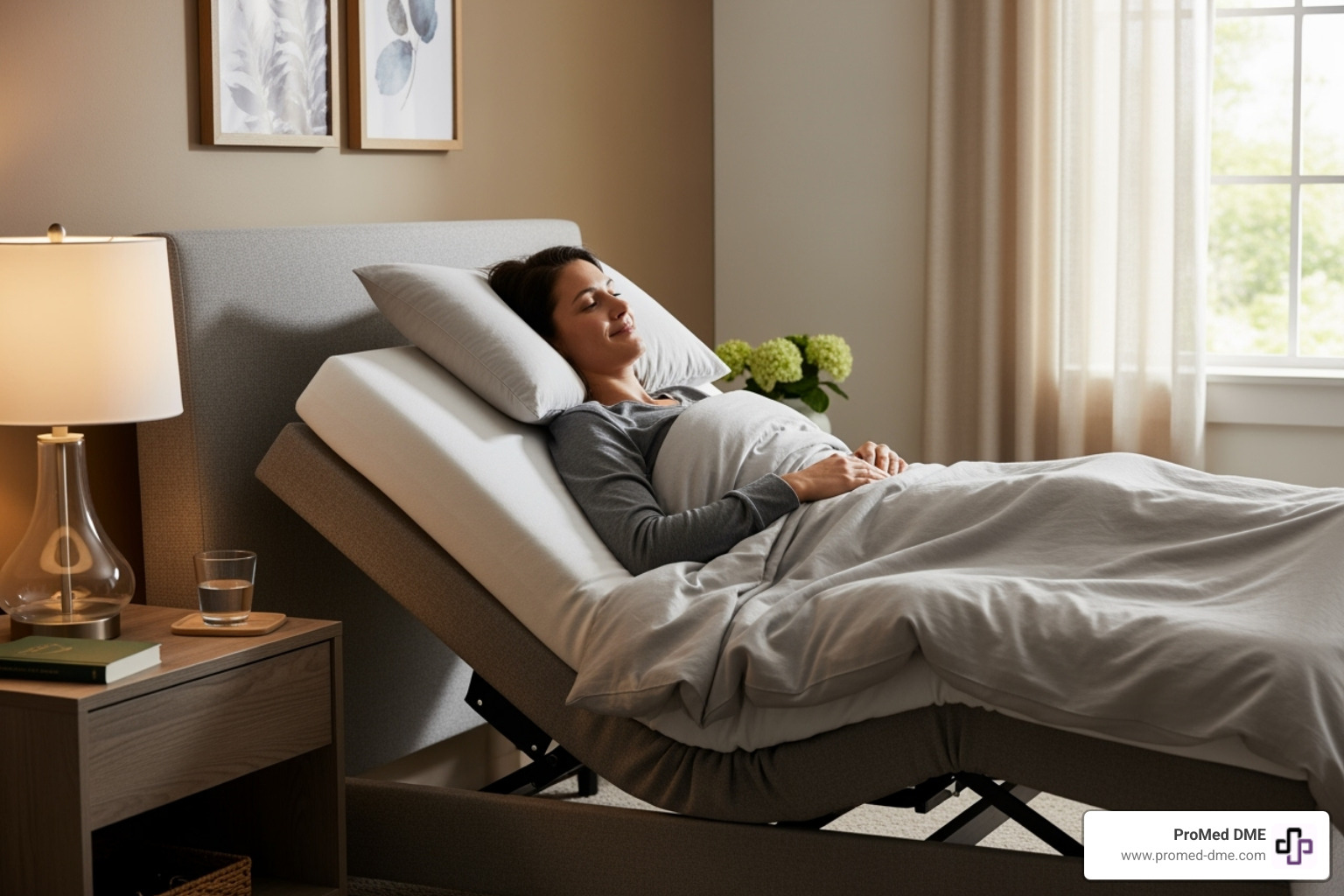Your Medicaid Medical Equipment Coverage: What You Need to Know

Why Understanding Medicaid Medical Equipment Coverage Matters
Does medicaid cover medical equipment? Yes, Medicaid covers medically necessary durable medical equipment (DME) and medical supplies when prescribed by a doctor for home use. However, coverage varies significantly by state, your specific Medicaid plan, and the type of equipment you need.
Quick Answer: What You Need to Know
- Coverage is mandatory - All state Medicaid programs must cover DME as a benefit category.
- Medical necessity required - Your doctor must prescribe the equipment and document why you need it.
- State rules vary - Each state defines coverage differently, with different approval processes.
- You may face barriers - Prior authorization, quantity limits, and copayments depend on your state.
- Children get broader coverage - The EPSDT benefit provides more comprehensive equipment coverage for those under 21.
If you're managing a chronic condition, you know that the cost of essential medical equipment like a wheelchair, hospital bed, or catheters can be a major concern. The good news is that Medicaid is designed to help. The challenge lies in navigating the different state programs and understanding what's covered.
While Medicaid does cover medical equipment, the process isn't always straightforward. You may need prior authorization, or your managed care plan might have different rules than another. This guide breaks down everything you need to know about Medicaid coverage for medical equipment, from wheelchairs to wound care supplies, so you can get the equipment you need without the confusion.

Understanding What Medicaid Covers: From Wheelchairs to Wound Care
When you're trying to figure out does Medicaid cover medical equipment, the answer depends on understanding two main categories: Durable Medical Equipment (DME) and medical supplies. Both are covered by Medicaid, but they're defined differently, and coverage varies depending on where you live.
¿Qué es un equipo médico duradero (EMD)?
Durable Medical Equipment refers to items built to last and designed to help you manage health conditions at home. For Medicaid to cover it, DME must be:
- Medically Necessary: Prescribed by a doctor as essential for your condition.
- For Home Use: Used in your personal residence, which can include an apartment or assisted living facility.
- Reusable: Designed to withstand repeated use over a long period (typically at least three years).
While the federal government sets these broad definitions, each state's Medicaid program has its own specific rules.
Common DME Covered by Medicaid:Most state Medicaid programs cover similar types of equipment when medically necessary, including:
- Mobility Aids: Wheelchairs (manual and powered), walkers, canes, and crutches.
- Home Care Equipment: Hospital beds and patient lifts.
- Respiratory Equipment: Oxygen concentrators, nebulizers, and CPAP machines.
- Other Devices: Blood glucose monitors, bedside commodes, orthotics, prosthetics, and suction pumps.
What About Medical Supplies?
Medical supplies are the consumable, often disposable, items you need regularly to manage your health. Common examples covered by Medicaid include:
- Incontinence Supplies: Adult diapers, briefs, and underpads.
- Urology Supplies: Catheters, leg bags, and drainage bags.
- Wound Care Items: Specialized dressings, bandages, gauze, and cleansers.
- Ostomy Supplies: Pouches and wafers.
- Diabetes Supplies: Test strips, lancets, and syringes.
- Breast pumps for new mothers.

Limitations and Exclusions
It's also important to know what Medicaid generally doesn't cover:
- Comfort Items: Items for convenience rather than medical necessity, like an air conditioner.
- Home Modifications: Structural changes like wheelchair ramps or widened doorways. However, some portable or removable items may qualify.
- Cost-Ineffective Options: If two items meet your needs, Medicaid will typically cover the less expensive one.
- Non-Medical Items: Equipment that could be seen as recreational, though exceptions can be made if a clear therapeutic purpose is documented.
Understanding these rules helps you and your doctor choose equipment that is likely to be approved. state-by-state DME coverage varies significantly, so always check your state's specific policies.
How to Get Your Medical Equipment: A Step-by-Step Guide
Getting medical equipment through Medicaid involves a few key steps. Following them in order can make the process much smoother.
Step 1: Get a Doctor's Prescription
A prescription is mandatory. Your healthcare provider must document your diagnosis and provide a clear medical justification for why the equipment is necessary for your treatment. This document, often called a Plan of Care, is the foundation of your request. The more detailed it is, the better your chances of a quick approval.
Step 2: Know Your Medicaid Plan
Medicaid programs vary by state and plan type.
- Fee-for-Service: The state Medicaid program pays providers directly.
- Managed Care Plans: Most beneficiaries are in these plans, which are run by private insurance companies. These plans have their own rules and networks of approved suppliers.
Check your Medicaid card or call the number on the back to confirm your plan type, DME benefits, and whether you must use in-network suppliers.
Step 3: Steer Prior Authorization (PA)
Prior Authorization (PA) is pre-approval from your Medicaid plan, often required for more expensive or specialized equipment. For example, about 33% of states require prior authorization for nebulizers. Your doctor or medical equipment supplier will submit the PA request with all the necessary medical documentation. This step is crucial and cannot be skipped.
At ProMed DME, we handle prior authorization paperwork for our customers, working directly with your doctor's office to gather all required information and streamline the process.
Step 4: Find a Medicaid-Approved Supplier
You must use a supplier that is enrolled in and approved by your specific Medicaid program. You can find these suppliers through your state Medicaid office website or your plan's provider directories. Your doctor's office can also recommend suppliers they've worked with successfully in the past.
Here's a practical tip: if you're in Florida, use the official "Find a licensed Florida facility" database to confirm a supplier is properly licensed. This protects you from unlicensed operations that might not deliver what they promise.
ProMed DME is a Medicaid provider in Florida, and we work with most insurance plans across the United States. We're based in Stuart, Florida, but we ship nationwide with free shipping. When you work with an experienced Medicaid supplier, they handle most of the complicated paperwork and communicate directly with your Medicaid plan.
Step 5: Understand Your Costs
One of the biggest advantages of Medicaid is that costs are typically very low, but "low" doesn't always mean "zero."
- Copayments: These vary dramatically by state. Some states have a $0 copay policy for medical equipment, while others charge small amounts. Statistics show that 49% of states have copays for nebulizers.
- Quantity limits: States often limit the amount of supplies you can receive at one time (e.g., a one-month vs. a three-month supply) to manage costs and ensure appropriate use.
Want to see how your state compares? The Kaiser Family Foundation maintains state-by-state DME coverage data that breaks down benefits across the nation. It's a helpful resource when you want to understand your specific state's policies.
At ProMed DME, we work directly with your insurance to minimize your expenses, and our team can tell you upfront what, if any, costs you'll be responsible for.
So, does medicaid cover medical equipment in every situation?
Yes, but coverage details can change based on your age, where you live, and whether you have other insurance like Medicare.

How does medicaid cover medical equipment for children?
For children and young adults under 21, Medicaid's Early and Periodic Screening, Diagnostic, and Treatment (EPSDT) benefit provides exceptionally robust coverage. This mandate requires coverage for any service needed to "correct or ameliorate" a health condition. This often means children can access a broader range of medical equipment and supplies than adults, such as specialized car seats or therapeutic tricycles, if deemed medically necessary.
What if I receive care at home or in a facility?
Where you receive care affects how you get your equipment:
- Skilled Nursing Facilities (SNFs): If you live in a Medicaid-approved facility, the facility is responsible for providing all necessary medical equipment. The cost is typically included in their payment from Medicaid.
- At Home (or Assisted Living): If you live in the community, you will follow the steps outlined earlier. Many states offer Home and Community Based Services (HCBS) Waivers, which can provide expanded DME coverage to help individuals remain at home rather than in an institution. The "Money Follows the Person" program is another initiative that helps purchase DME to facilitate the transition from nursing homes back to community living.
How does medicaid cover medical equipment compared to Medicare?
It's common to confuse Medicaid and Medicare, especially when it comes to medical equipment. While both are government-funded programs, their coverage for DME has key differences:
| Feature | Medicaid Coverage -| Eligibility | Low-income individuals, families, children, and people with disabilities. Eligibility varies by state. | Generally, people 65+, or certain younger people with disabilities, or people with End-Stage Renal Disease. || Costs | Typically low or no copayments, but this varies by state and plan. Some states have $0 copay. | After meeting the Part B deductible, you pay 20% of the Medicare-approved amount if the supplier accepts assignment. || Definition | Items for home use, medically necessary, not generally useful without illness/injury, can withstand repeated use. Flexibility in definition by state. | Equipment that is durable (can withstand repeated use), used for a medical reason, typically only useful to someone who is sick or injured, used in your home, and expected to last at least 3 years. || Rental vs. Purchase | May rent, buy, or use a rent-to-purchase option based on medical necessity and cost-effectiveness. States have flexibility. | May rent or buy equipment. Some items become yours after a certain number of rental payments (e.g., after 13 months for certain DME). || State Variation | Significant variation in coverage, prior authorization, and quantity limits by state and specific Medicaid program/waiver. | Generally uniform across states, but Medicare Advantage plans may have different rules (e.g., prior authorization, in-network suppliers). |
For a deeper dive into Medicare's specific DME coverage, we encourage you to consult Medicare's official DME guide.
What to Do If Medicaid Denies Your DME Request
A denial letter from Medicaid for medical equipment can be frustrating, but it's not the final word. You have the right to appeal, and many denials can be successfully overturned.
Understanding the Denial
When Medicaid denies your request, they must send a written explanation. This letter is your roadmap for what to do next. It will tell you exactly why they said no and explain your right to appeal, including critical deadlines.
Common reasons for denial include:
- Insufficient proof of medical necessity
- Incomplete or incorrect paperwork
- The requested item is not covered
- Using a supplier that is not in-network
The Appeal Process
- Gather Documentation: Work with your doctor to strengthen your case. This may involve a more detailed letter of medical necessity, additional test results, or a revised Plan of Care. Correct any simple errors on the original application.
- File an Internal Appeal: If you have a Medicaid managed care plan, your first step is to file an appeal directly with them. Contact their customer service for instructions.
- Request a State Fair Hearing: If the internal appeal is denied, or if you have a fee-for-service plan, you can request a state fair hearing. An impartial officer will review your case and make a final decision.
Deadlines are absolutely critical throughout this process. Keep detailed records of all communication and paperwork to ensure you don't miss a step.

We're Here to Help
Navigating insurance paperwork and appeals can be overwhelming. At ProMed DME, our experienced team, including a dedicated nurse, can help you gather the right documentation and understand your plan's requirements. We work with most insurance plans to get you the equipment you need with minimal out-of-pocket expense. You don't have to do it alone.
Preguntas frecuentes
We hear many questions about Medicaid coverage for medical equipment. Here are some of the most common ones we encounter:
Does Medicaid cover supplies for chronic conditions like asthma or diabetes?
Yes, absolutely. Medicaid covers essential supplies for managing chronic conditions. For diabetes, this typically includes blood glucose monitors, test strips, lancets, and syringes. For asthma and other respiratory conditions, coverage often includes nebulizers, peak flow meters, and valved-holding chambers (spacers). While coverage is widespread, some states may require prior authorization or have quantity limits. For more details, the American Lung Association offers a helpful guide on Medicaid coverage for asthma devices.
Does Medicaid cover wheelchair repairs?
Yes, in most cases, Medicaid does cover wheelchair repairs. This is part of Medicaid's obligation to provide equipment in "sufficient amount, duration, and scope," which includes keeping it in working order. This is crucial, as nearly 64% of wheelchair users need repairs. Some states have specific policies, such as authorizing a replacement if the repair cost exceeds a certain percentage of the original price. If your wheelchair needs repair, contact your Medicaid plan or supplier to understand the process. At ProMed DME, our team can help you steer getting your equipment repaired or replaced.
Are there copayments for medical equipment with Medicaid?
Whether you'll have a copayment depends on your state and specific plan. Some states have a $0 copay policy for medical equipment. Others charge small copayments, usually just a few dollars. For example, 2018-2019 data showed that 49% of states had copays for nebulizers. The best way to know what you might pay is to check directly with your Medicaid plan. At ProMed DME, we can help you understand your coverage and any potential out-of-pocket costs.
Conclusión
Navigating Medicaid for medical equipment can seem complex, but understanding the process is the key to getting the supplies you need. The answer to does medicaid cover medical equipment? is yes, provided it's medically necessary and prescribed by a doctor.
Remember these key takeaways:
- Medical necessity is crucial. A doctor's prescription and detailed justification are required.
- Rules vary. Coverage details, prior authorization, and costs depend on your state and specific Medicaid plan.
- You have rights. If your request is denied, you can and should appeal the decision.
Understanding these points empowers you to advocate for your health and access the equipment that supports your independence and quality of life.
At ProMed DME, we're committed to making this process as smooth as possible. We provide a wide range of top-quality durable medical supplies—including urology, diabetes, wound care, and bracing products—and we ship across the United States. Our dedicated team, including an on-staff nurse, is here to help you steer insurance paperwork and minimize your out-of-pocket expenses.
Don't let confusion stand between you and the care you deserve. Whether you have questions or are ready to order your supplies, we're here to help.
Recursos y artículos relacionados
Manténgase informado con las entradas de nuestro blog informativo.
Descubra las ventajas de ProMed
y pruebe nuestros productos
Ofrecemos envío gratuito y un legendario servicio de atención al cliente para garantizar que reciba los
mejores productos de DME para sus necesidades.



